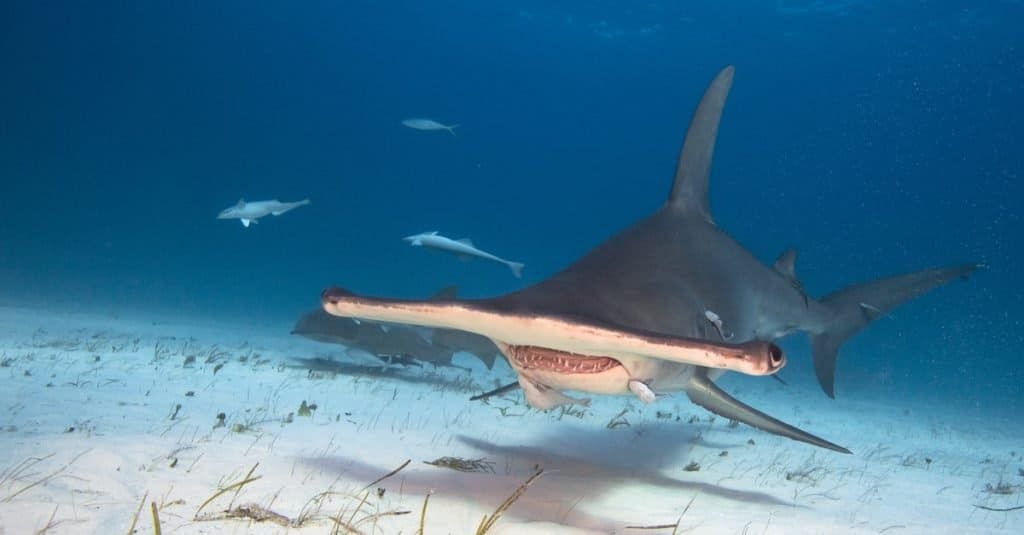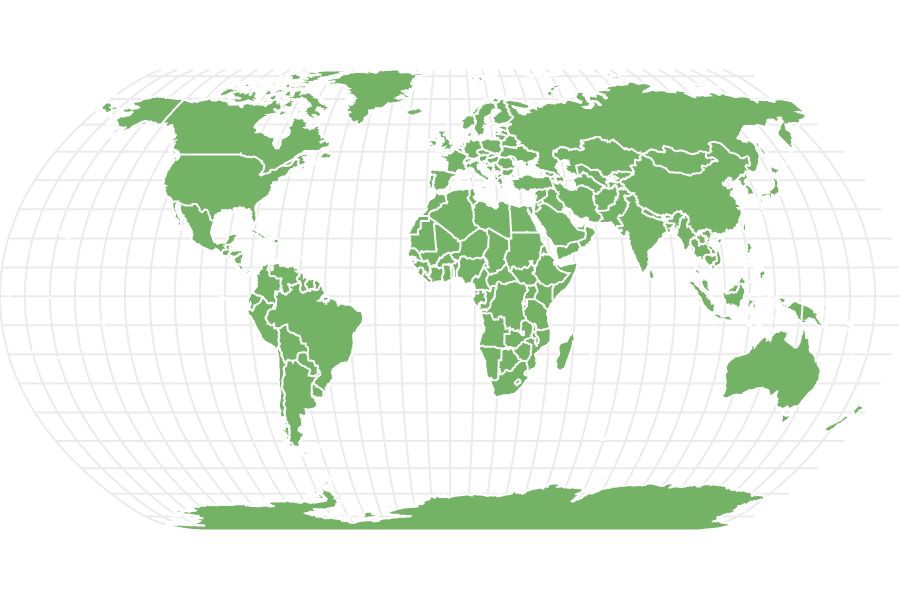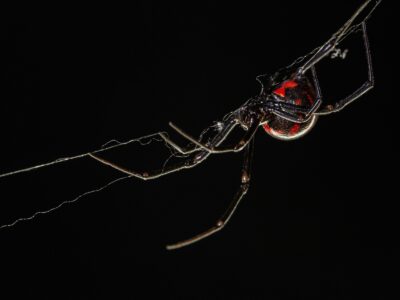Great Hammerhead Shark
.jumbotron {
background-image: url(“https://a-z-animals.com/media/2022/06/Great-Hammerhead-Shark-header-400×300.jpg”);
}
}
@media only screen and (min-width: 641px) and (max-width: 920px) {
.jumbotron {
background-image: url(“https://a-z-animals.com/media/2022/06/Great-Hammerhead-Shark-header-470×370.jpg”);
}
}
@media only screen and (min-width: 921px) {
.jumbotron {
background-image: url(“https://a-z-animals.com/media/2022/06/Great-Hammerhead-Shark-header.jpg”);
}
}
Great Hammerhead Shark
Sphyrna mokarran
Great hammerhead sharks have a 360 view because their eyes are situated on the ends of their mallet-like heads.
Great Hammerhead Shark Scientific Classification
- Kingdom
- Animalia
- Phylum
- Chordata
- Class
- Chondrichthyes
- Order
- Carcharhiniformes
- Family
- Sphyrnidae
- Genus
- Sphyrna
- Scientific Name
- Sphyrna mokarran
Read our Complete Guide to Classification of Animals.
Great Hammerhead Shark Conservation Status
Great Hammerhead Shark Facts
- Prey
- Squids, Fish, Crustaceans, small sharks, sting rays, cephalopods
- Name Of Young
- Pups
- Group Behavior
-
- Solitary
- Fun Fact
- Great hammerhead sharks have a 360 view because their eyes are situated on the ends of their mallet-like heads.
- Biggest Threat
- Killer Whales
- Most Distinctive Feature
- Head is shaped like a hammer
- Distinctive Feature
- Head shaped like a hammer
- Gestation Period
- 11 months
- Temperament
- Aggressive
- Litter Size
- 6-42 pups
- Habitat
- Shallow waters over continental shelves and island terraces
- Predators
- Killer Whales, Bull sharks
- Diet
- Carnivore
- Average Litter Size
- 6-42 pups
- Number Of Species
- 9
- Location
- Indian ocean, Atlantic ocean, Pacific ocean, Mediterranean Sea
- Migratory
- 1
Great Hammerhead Shark Physical Characteristics
- Color
-
- Brown
- Grey
- White
- Olive
- Grey-Brown
- Skin Type
- Scales
- Top Speed
- 20 mph
- Lifespan
- 20-30 years
- Weight
- 900-1280 pounds
- Length
- 10-14 feet
- Age of Sexual Maturity
- 8-9 years
- Age of Weaning
- From birth
- Venomous
- No
- Aggression
- High
This post may contain affiliate links to our partners like Chewy, Amazon, and others. Purchasing through these helps us further the A-Z Animals mission to educate about the world’s species..

Spiders that fly! Fish that walk! And 1000+ more incredible animals. Discover them all for FREE
.photo-gallery {
–margin: 0px auto 0px;
–padding: 0px 0px 0px 0px;
}
.gallery-link {
background-image: url(“https://a-z-animals.com/media/2022/06/Great-Hammerhead-Shark-header-1024×614.jpg”);
background-repeat: no-repeat;
background-size: cover;
background-position: center;
height: 500px;
justify-content: center;
text-align: center;
align-items: center;
display: flex;
border: 2px solid #000;
}
.gallery-link img {
height: 50%;
}
@media only screen and (max-width: 768px) {
.gallery-link {
height: 300px !important;
}
}
View all of the Great Hammerhead Shark images!
“The heaviest great hammerhead shark ever recorded weighed a whopping 1280 pounds”
The great hammerhead shark is found in warmer waters and is the biggest of nine subspecies. Generally, they grow up to 10-14 feet long. However, there are records of a female over 20 feet!
Great hammerhead sharks are solitary animals that migrate to warmer waters during winter. The females give birth to between 6 t-42 pups every 24 months.
Great Hammerhead Shark Facts
- The longest great hammerhead shark measured at 20ft, and the heaviest weighed a whopping 1280 pounds!
- Great hammerhead sharks prefer shallow waters and are usually found up to 262 feet deep. However, they have been found at depths of 984 feet.
- Researchers believe great hammerhead sharks are cannibalistic and sometimes eat their own young.
- Great hammerhead sharks love to eat stingrays and have been found with their stingers protruding from their mouths, which means they are immune to their venom.
- The great hammerhead shark’s gestation period lasts for 11 months, and they give birth to between 6-42 pups.
Great Hammerhead Shark Scientific Name
The great hammerhead shark’s scientific name is Sphyrna mokarran, a mixture of Greek and Arabic meaning, “great hammer.”
button.pulse {
transform: scale(1); animation: pulse 2s infinite;
box-shadow: 0 0 0 0 rgba(11, 247, 25, 1);
}
@keyframes pulse {
0% { transform: scale(0.90); box-shadow: 0 0 0 0 rgba(11, 247, 25, 0.5); }
60% { transform: scale(1); box-shadow: 0 0 0 15px rgba(11, 247, 25, 0); }
100% { transform: scale(0.90); box-shadow: 0 0 0 0 rgba(11, 247, 25, 0); }
}
A German naturalist explorer Wilhelm Peter Eduard Simon Rüppell first discovered the species in 1837. Because of his two major expeditions to northern Africa in 1817, he helped create the Natural History Society.
On his second expedition from 1831 to 1834, near Eritrea on the Red Sea, Wilhelm witnessed a great hammerhead shark stranded on a sandbank while trying to catch its prey.
He noticed that it differed from the four species already documented by French zoologist Achille Valenciennes. So Wilhelm crowned it with the Arabic name mokarran, which means “Great.”
The male was an astounding 9.5 feet, and they released it unharmed. This legendary explorer also documented other shark species like:
- Milk Shark (Rhizoprionodon)
- Whitetip Reef Shark (Triaenodon obesus)
- Silvertip Shark (Carcharhinus albimarginatus)
- Lemon Shark (Negaprion acutidens)
There are nine species of hammerhead sharks, all with different characteristics and features; they include:
Scalloped Hammerhead Shark
Size: 14 feet
Habitat: Found in tropical waters worldwide.
IUCN Red List Status: Critically Endangered
The scalloped hammerhead is one of the bigger of the species. However, they are hard to misidentify because of the multiple notches on their flat, narrow heads, making them look like scallop shells.
Their gestation period lasts one year, and they give birth to around 12-38 pups. The pups have been known to take protection in between the mangrove trees in estuaries and bays.
Unlike most sharks, they gather in schools, with the majority females, and hunt together. Their preferred foods include:
Smooth Hammerhead Shark
Size: 16 feet
Habitat: Prefers temperate water but occurs worldwide.
IUCN Red List Status: Vulnerable
The smooth hammerhead is the second biggest of the species. It derived its name from the glossy texture of its head, unlike its cousins, the great and scalloped hammerheads with notches on their cephalofoil (flat and narrow head).
They prefer temperate water and will migrate to the equator during winter and back to the poles for the summer. The smooth hammerhead shark is generally found in the shallow waters of bays, estuaries, and oceanic islands.
Their preferred food includes:
- Herring
- Mackerel
- Seabass
- Smaller sharks
- Octopus
- Squid
- Crustaceans
- Stingrays
Winghead Shark
Size: 6.2 feet
Habitat: Prefers shallow, tropical waters in the Western Indo-Pacific region of the Indian Ocean.
IUCN Red List Status: Endangered
The winghead shark has a peculiarly broad head, and its width can be half the shark’s length. That’s why it’s also known as the slender hammerhead shark.
They have slender bodies, and their color differs from gray to brown, with a tall dorsal fin. An identifying feature is an indentation in the center of its head with small bumps on either side of the nostrils.
The slender hammerhead has phenomenal vision and expansive views because of its abnormally wide head. In addition, their large nostrils provide them with a great sense of smell, and they can follow odors from miles away.
They are found off the Persian Gulf and the Western Indo-Pacific region in tropical, shallow waters, as they like to hunt on the ocean floor.
Their preferred foods include:
- Herring
- Cephalopods
- Crustaceans
Their gestation period lasts 11 months, and the female gives birth to around 25 pups.
Bonnethead Shark
Size: 4.9 feet
Habitat: Found predominantly on the North and South American coasts in tropical estuaries and bays.
IUCN Red List Status: Endangered
The bonnethead is one of the smaller sharks of the species. It has a rounded head, which is why it is often referred to as the shovelhead shark.
The bonnethead uses its pectoral fins for swimming, which is different from how the other hammerhead sharks swim due to its small body size.
Another unique characteristic is that females have different heads than males. The females have a smooth rounded head, while the males have a noticeable bump in the center.
Their preferred location is the Atlantic and Pacific oceans, close to the North and South American coasts. However, due to the drastic overfishing done in the area, their numbers have severely declined.
Bonnetheads are the only species of hammerhead sharks that are omnivores. They eat both plants like seagrass and crustaceans like shrimps, small fish, and blue crabs.
Scalloped Bonnethead Shark
Size: 3 feet
Habitat: Eastern Pacific coast in tropical and subtropical waters.
IUCN Red List Status: Critically Endangered
The scalloped bonnethead shark is similar to the bonnethead shark, with two distinctive features. First, instead of a smooth, rounded head, they have indentations. Therefore, they are often called the crown or mallet head shark.
Secondly, they are the smallest of the hammerhead shark species, and unlike most shark species, the males grow bigger than the females.
Due to intense overfishing in the area, the scalloped bonnethead is the rarest of all hammerhead sharks. They prefer the tropical waters of the eastern Pacific Ocean between Mexico and Peru.
Their pups are left to fend for themselves from birth and hide in the estuary’s mangrove forests to avoid predators.
Scalloped bonnethead sharks like to hunt in soft seabeds and eat:
- Mollusks
- Cephalopods
- Crustaceans
Scoophead Shark
Size: 5 feet
Habitat: They inhabit the shallow, tropical waters of the Western Atlantic and Eastern Pacific coasts.
IUCN Red List Status: Critically Endangered
There is not much known about the scoophead shark. They frequent the tropical waters of the Western Atlantic and Eastern Pacific coasts and look like the scalloped bonnethead. However, they are 2 feet bigger, their mouths have a wider arch, and their nose is shorter.
Their favorite meals are:
- Octopus
- Squid
- Small sharks
- Flounders
Their numbers have decreased significantly due to juvenile habitat loss. The pups hide in Mangrove forests which have been destroyed over the years. Predators can find and eat the pups because they cannot hide in the forests.
Smalleye Hammerhead Shark
Size: 4.9 feet
Habitat: South Americas Eastern coast’s shallow and muddy water.
IUCN Red List Status: Critically Endangered
Smalleye hammerheads are easy to identify due to the sections of bright gold on their heads and bodies, giving them the nicknames golden hammerheads or curry sharks.
The golden color is believed to come from the diet of smalleye hammerhead sharks. The shrimps and catfish, along with their eggs, have a golden pigment that affects the coloring of the juvenile sharks. This unique coloring helps them camouflage in the muddy waters they inhabit.
But the reason behind their common name, smalleye shark, is due to their abnormally small eyes relative to their bodies. In addition, their heads are shaped like mallets and have a predominant indentation in the center.
Although they give birth to about 19 pups each year, their vulnerability to overfishing has seen a significant decline in their population on the South American east coast.
Carolina Hammerhead Shark
Size: 14 feet
Habitat: The temperate waters of the Western Atlantic Ocean Coast.
IUCN Red List Status: Unknown
This species of the hammerhead shark is the most recently discovered out of the nine subspecies. It was documented by Carter Gilbert in 1967 when a specimen was caught off Charleston, SC.
At first, they believed it was a scalloped hammerhead, but after taking a closer look, unique characteristics revealed it was a separate species.
While the two species look almost identical, they are completely different internally. The Carolina hammerhead has ten fewer vertebrae, and its genetic material also differs from the scalloped hammerhead.
Not much else is known about this shy species, but they are much rarer than the scalloped shark. In addition, knowledge about their distribution is limited to the western Atlantic Ocean and South Carolina waters, where they prefer to give birth.
Great Hammerhead Shark Appearance and Behavior
The great hammerhead is a solitary predator but has been known to swim in schools from time to time. They are aggressive hunters and will attack if threatened. Although they do not actively seek out humans, attacks have been recorded.
However, there have only been 16 attacks documented between 1900 and the present, and none of them resulted in death. The majority of these attacks have occurred off the coast of Florida, California, and Australia.
Because their eyes sit on the edge of their mallet-shaped heads, they have excellent eyesight and a 360 view of their surroundings, making them skilled hunters.
In addition, they have a group of sensory organs called the ampullae of Lorenzini. Its function is to detect electrical fields created by other animals. This aids the great hammerhead in finding its food, especially prey like flounders or stingrays that hind under the sand.
They can reach lengths of 20 ft. and can weigh up to 1,280 pounds! In addition, their coloring differs from olive green to brownish-gray with an off-white underbelly.
Their sharp triangular teeth are heavily serrated and have an elongated dorsal fin that is easy to identify.

frantisekhojdysz/Shutterstock.com
Great Hammerhead Shark Habitat
Great Hammerhead Sharks are found worldwide, mostly in shallow waters over continental shelves and island terraces.
However, they also venture out to deeper waters well offshore. They are generally found at depths of 3 feet but can reach depths of 262 feet if needed. Their favorite habitats are usually continental and insular coral reefs with abundant food.
Great Hammerhead Shark Diet
The great hammerhead shark is no picky eater; they have a broad diet that includes:
- Stingrays
- Small sharks
- Bony fish
- Crustaceans
- Squid
- Octopus
They use their unique sensory function, electroreception, and 360 vision to find their prey and pin them down so they can’t swim away.
Great Hammerhead Shark Predators and Threats
Due to the great hammerhead shark’s immense size, it has few known predators. However, bull sharks prey upon the pups, and the adults are hunted and killed by killer whales.
Their biggest threat is the human race because severe overfishing has led to the decline of this unique species.
Their large pectoral fins are of great value in the Chinese market, which is why fishermen target them. In addition, their habitat is dwindling, and they are listed as critically endangered on IUCN’s Red List.
Another interesting fact is scientists have documented cannibalism within the species. Some adults will attack, kill, and eat the pups.
Great Hammerhead Shark Reproduction, Babies, and Lifespan
Their reproduction process is similar to other sharks, where the male uses his clasper to fertilize the female’s eggs through her cloaca.
Great hammerheads reproduce in a Viviparous nature. The mother’s eggs hatch inside of the uterus, and she gives live birth to about 6-42 pups.
While in the uterus, the pups receive nutrients through an umbilical cord connected between their pectoral fins, which is attached to a placenta. The female’s gestation period lasts 11 months; once the pups are born, they are left to fend for themselves. While this doesn’t sound very maternal, the females give birth in bays or estuaries where Mangroove forests can shield and protect the pups. If the pups reach adulthood, their average lifespan is between 20 and 30 years.
Great Hammerhead Shark Population
There is no data that exists on the great hammerhead’s population size. But unfortunately, there is data suggesting that their population is on the decline, which is why they are listed as critically endangered.
Great hammerhead sharks in the Indian Ocean, Mediterranean Sea, and Atlantic Ocean have significantly decreased in their populations. Scientists have concluded that their population has reduced by 80% in the last 70 years.
Great Hammerhead Shark In the Zoo
If you ever want to see one of these majestic creatures for yourself, it is possible, and you don’t need to endure a grueling sea voyage. So, why not take a road trip or extended holiday to one of these locations to see them firsthand:
- Adventure Aquarium, Camdon, NJ
- Atlantis Paradis Island Resort, Bahamas
- Georgia Auquarium, Atlanta
- Shark Reef Exhibit, Las Vegas, Nevada
View all 115 animals that start with G
Great Hammerhead Shark FAQs (Frequently Asked Questions)
Are great hammerheads sharks aggressive?
They are aggressive hunters and will attack if threatened. Although they do not actively seek out humans, attacks have been recorded.
What’s the difference between and hammerhead shark and a great hammerhead shark?
All hammerhead sharks have a unique mallet-like shaped head. However, the great hammerhead shark’s head is straighter and has a notch in the center.
Are Great Hammerhead sharks rare?
Yes, they are listed as critically endangered on the IUCN Red List.
Does the great hammerhead shark have any predators?
Yes, bull sharks prey on the juvenile great hammerhead sharks, and the adults are preyed upon by killer whales.
Do great hammerhead sharks give birth to live young?
Yes, great hammerhead sharks give live birth to about 6 to 42 pups every two years.
Sources
- Wikipedia, Available here: https://en.wikipedia.org/wiki/Great_hammerhead
- Oceana, Available here: https://oceana.org/marine-life/great-hammerhead-shark/
- Shark Research Institute, Available here: https://www.sharks.org/great-hammerhead-shark-sphyrna-mokarran
- National Geographic, Available here: https://www.nationalgeographic.com/animals/fish/facts/hammerhead-sharks
- Marine Bio, Available here: https://www.marinebio.org/species/great-hammerhead-sharks/sphyrna-mokarran/
- Florida Mudeum, Available here: https://www.floridamuseum.ufl.edu/discover-fish/species-profiles/sphyrna-mokarran/
- Britannica, Available here: https://www.britannica.com/animal/great-hammerhead
- IUCN Red List, Available here: https://www.iucnredlist.org/species/39386/2920499
















